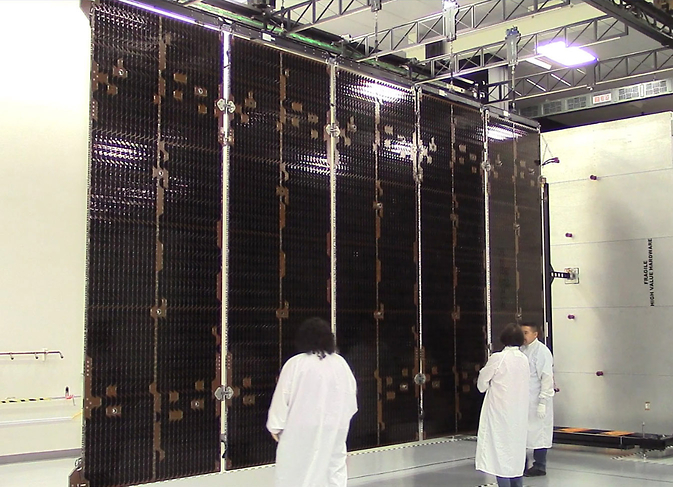NOAA GOES-R Satellite Black Wing Ready for Flight

This photo shows a successful deployment of the GOES-R satellite solar array in a Lockheed Martin clean room in Sunnyvale, California, on May 13, 2014. Image Credit: Lockheed Martin
On May 13, 2014, the GOES-R satellite solar array panels were successful deployed in a Lockheed Martin clean room in Sunnyvale, California. The completed solar array was then delivered to Lockheed Martin’s facility near Denver.
“The GOES-R solar array generates more than 4,000 watts of power, twice as much as that of the previous generation of GOES satellites, in order to operate the larger and more capable instruments carried by GOES-R,” said Pam Sullivan, GOES-R flight project manager at NASA’s Goddard Space Flight Center in Greenbelt, Maryland.
The GOES-R spacecraft uses a photovoltaic solar array to derive electricity from sunlight. Photovoltaics is a method that uses semiconductors to convert solar radiation into direct current electricity.
The solar array is comprised of five separate solar panels that are folded up at launch. After the satellite is released by the launch vehicle, the solar panels are deployed into a single solar array wing that rotates once per day on orbit to continuously point the solar array photovoltaic cells towards the sun.
The solar array provides a stable platform that tracks the seasonal and daily movement of the sun relative to the spacecraft. It will power all of the instruments, including the computers, data processors, attitude control sensors and actuators, and telecommunications equipment.
The instruments include the Extreme Ultraviolet and X-ray Irradiance Sensors (EXIS), the Magnetometer, the Space Environment In-Situ Suite (SEISS), Solar Ultraviolet Imager (SUVI), the Advanced Baseline Imager (ABI), Geostationary Lightning Mapper (GLM), and Unique Payload Services (UPS).
The UPS suite consists of transponder payloads providing communications relay services in addition to the primary GOES mission data. The UPS suite consists of the Data Collection System (DCS), the High Rate information Transmission / Emergency Managers Weather Information Network (HRIT/EMWIN), GOES-R Rebroadcast (GRB), and the Search and Rescue Satellite Aided Tracking (SARSAT) System.
The GOES-R, or Geostationary Operational Environmental Satellite – R Series, advanced spacecraft and instrument technology will result in more timely and accurate weather forecasts. It will improve support for the detection and observations of meteorological phenomena and directly enhance public safety, protection of property, and ultimately, economic health and development.
GOES-R will be more advanced than NOAA's current GOES fleet. The satellites are expected to more than double the clarity of today's GOES imagery and provide more atmospheric observations than current capabilities with more frequent images.
NOAA, the National Oceanic and Atmospheric Administration, manages the GOES-R Series Program through an integrated NOAA-NASA program office, staffed with personnel from NOAA and NASA, and co-located at NASA's Goddard Space Flight Center in Greenbelt, Maryland.
Related links
› More information about NOAA's Satellite and Information Service
› GOES-R project website
Media Contact
All latest news from the category: Physics and Astronomy
This area deals with the fundamental laws and building blocks of nature and how they interact, the properties and the behavior of matter, and research into space and time and their structures.
innovations-report provides in-depth reports and articles on subjects such as astrophysics, laser technologies, nuclear, quantum, particle and solid-state physics, nanotechnologies, planetary research and findings (Mars, Venus) and developments related to the Hubble Telescope.
Newest articles

Superradiant atoms could push the boundaries of how precisely time can be measured
Superradiant atoms can help us measure time more precisely than ever. In a new study, researchers from the University of Copenhagen present a new method for measuring the time interval,…

Ion thermoelectric conversion devices for near room temperature
The electrode sheet of the thermoelectric device consists of ionic hydrogel, which is sandwiched between the electrodes to form, and the Prussian blue on the electrode undergoes a redox reaction…

Zap Energy achieves 37-million-degree temperatures in a compact device
New publication reports record electron temperatures for a small-scale, sheared-flow-stabilized Z-pinch fusion device. In the nine decades since humans first produced fusion reactions, only a few fusion technologies have demonstrated…





















